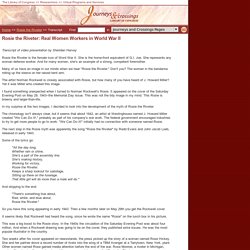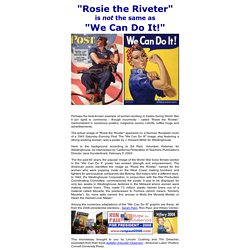

Inside Our Archives. Rosie the Riveter. Rosie la riveteuse - 8 mars. Représentation des femmes qui allèrent travailler dans les usines, Rosie la riveteuse est une icône féministe alliant détermination, force et féminité.

Rosie the Riveter (« Rosie la riveteuse » en français) est une une icône populaire de la culture américaine, symbolisant les six millions de femmes qui travaillèrent dans l’industrie de l’armement et qui produisirent le matériel de guerre. Lors de la Seconde Guerre mondiale, le gouvernement américain lance une campagne pour encourager les femmes à participer à l’effort de guerre, en s’employant comme ouvrières, pour remplacer les hommes partis au front. L’affiche la plus célèbre de cette campagne de propagande fut « We Can Do It ! » (« Nous pouvons le faire ! Rosie la riveteuse, De l'effort de guerre au féminisme - Art et Histoire au carré. Nous sommes au cœur de la seconde guerre mondiale.

AuxEtats-Unis, les hommes sont enrôlés sur le front, en Europe et dans lepacifique. Les bras manquent dans les usines pour les remplacer. Legouvernement américain lance donc une campagne pour encourager les femmes àparticiper à l’effort de guerre, en s’employant comme ouvrières. Néanmoins,elles sont souvent cantonnées à certaines tâches, notamment le rivetage ouencore le câblage électrique des avions. Elles travaillent surtout dans lesindustries légères à des postes peu qualifiés. Rosie la riveteuse. Rosie the Riveter - Norman Rockwell. Rosie the Riveter Transcript (Journeys and Crossings, Library of Congress Digital Reference Section) Transcript of video presentation by Sheridan Harvey Rosie the Riveter is the female icon of Word War II.

She is the home-front equivalent of G.I. Joe. She represents any woman defense worker. And for many women, she's an example of a strong, competent foremother. Many of us have an image in our minds when we hear "Rosie the Riveter. " The artist Norman Rockwell is closely associated with Rosie, but how many of you have heard of J.
I found something unexpected when I turned to Norman Rockwell's Rosie. In my surprise at the two images, I decided to look into the development of the myth of Rosie the Riveter. The chronology isn't always clear, but it seems that about 1942, an artist at Westinghouse named J. The next step in the Rosie myth was apparently the song "Rosie the Riveter" by Redd Evans and John Jacob Loeb, released in early 1943. Some of the lyrics go: "All the day long, Whether rain or shine, She's a part of the assembly line. And skipping to the end: "The women worked in pairs. Rosie the Riveter : Analyse de l'icône Américaine. Rosie the Riveter représentait l’icône de l’effort de guerre des femmes lors de la Seconde Guerre Mondiale.

Zoom sur ce personnage mythique peu connu… Howard Miller can do it ! Alors que les hommes étaient partis au front, le gouvernement américain décida de lancer une campagne afin de recruter un maximum de femmes possible dans les usines d’armement. Cette campagne avait pour but non seulement d’encourager les femmes à travailler pour l’effort de guerre mais aussi à convaincre les hommes dont la majorité était contre le travail des femmes notamment depuis la Grande Dépression où les femmes qui travaillaient étaient accusées de voler le travail des hommes pourtant cruellement manquant. Rockwell%27s+Rosie+Crop.jpg (JPEG Image, 345 × 257 pixels) Feet+of+Rosie+the+Riveter+on+Hitler%27s+Mein+Kampf+book+Crystal+Bridges+Museum.jpg (JPEG Image, 1600 × 1200 pixels) - Scaled (64%) Crystal Bridges Museum Collection. Norman Rockwell’s Rosie the Riveter Joins Crystal Bridges’ Collection - Park West Gallery.
Courtesy of Crystal Bridges Museum of American Art BENTONVILLE, Ark., June 8, 2009 – Norman Rockwell’s painting Rosie the Riveter, an immensely popular icon of the American work ethic, is now part of the permanent collection at Crystal Bridges Museum of American Art.

Painted for the May 29, 1943 cover of the Saturday Evening Post, Rosie the Riveter depicts a strong, capable feminine figure on the home front work effort during World War II. “Rockwell’s thoroughly modern Rosie not only addresses the war effort as touching all American lives but a ‘can do’ spirit and the emergence of women into the workforce during a time of national crisis,” said Chris Crosman, chief curator at Crystal Bridges. “She is emblematic of a sea change in American culture,” said Crosman. “Importantly, the artist’s depiction celebrates, even helps to invent, due to mass distribution as a War Bond poster and magazine cover, the beginnings of gender equality.”
Norman Rockwell Exhibit. Rosie the Riveter by Norman Rockwell This iconic painting was done by perhaps America's most beloved painter of the 20th Century.

It currently is in the permanent collection of Crystal Bridges Museum of American Art, in Bentonville, Arkansas. Right now Rosie has guests. The museum is currently host to over original 50 paintings and sketches as well as EVERY Saturday Evening Post cover that Rockwell did, and that's over 300. The exhibit is stunning. I did capture a couple of images before I noticed the sign that prohibited such activities.
Rockwell was the consummate illustrator. My wife and I got to the museum when it opened this morning at 11:00. I found the image I was looking for. "Rosie the Riveter" is not the same as "We can do it!" Perhaps the best-known example of women working in trades during World War II [on right] is commonly - though incorrectly - called “Rosie the Riveter,” memorialized in numerous posters, magazine covers, t-shirts, coffee mugs and advertisements.

The actual image of "Rosie the Riveter" appeared on a Norman Rockwell cover of a 1943 Saturday Evening Post. The "We Can Do It! " image, also featuring a strong working woman, was a poster by J. Howard Miller for Westinghouse. Here is the background according to Ed Reis, Volunteer Historian for Westinghouse, as interviewed by California Federation of Teachers Publications Director Jane Hundertmark, February 5, 2003: “For the past 60 years, the popular image of the World War II-era female worker in the “We Can Do It” poster has evoked strength and empowerment. Among the numerous adaptations of the "We Can Do It! " This microessay brought to you by Lincoln Cushing and Tim Drescher, excerpted from their book Agitate! Rosie the Riveter Transcript (Journeys and Crossings, Library of Congress Digital Reference Section)
Nous pouvons le faire ! [Rosie la Riveteuse] Cette affiche, produite par Westinghouse pendant la Seconde guerre mondiale pour le comité de coordination de la production de guerre, faisait partie d'une campagne nationale aux États-Unis visant à enrôler des femmes dans la main-d'œuvre.
![Nous pouvons le faire ! [Rosie la Riveteuse]](http://cdn.pearltrees.com/s/pic/th/riveteuse-bibliotheque-98866614)
Face à la grave pénurie de main d'œuvre en temps de guerre, les femmes étaient nécessaires dans les industries de défense, le service civil, et même les forces armées. Des campagnes de publicité visèrent à encourager ces femmes qui n'avaient jamais occupé d'emploi à rejoindre la main-d'œuvre. Des images d'affiche et de film glorifiaient le rôle des femmes au travail et suggéraient que leur féminité n'était pas sacrifiée pour autant. Les femmes sont dépeintes comme attirantes, confiantes, et résolues à apporter leur contribution pour gagner la guerre.